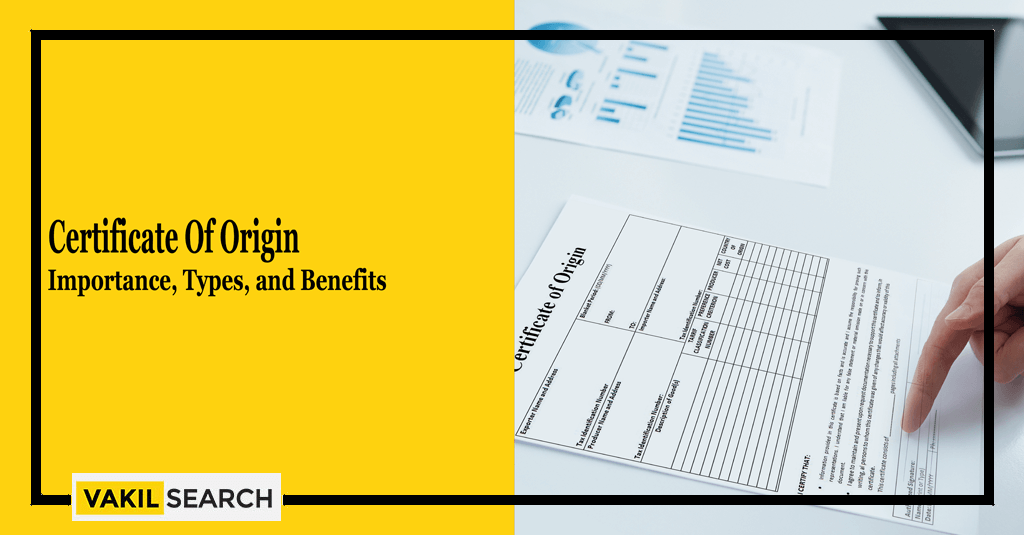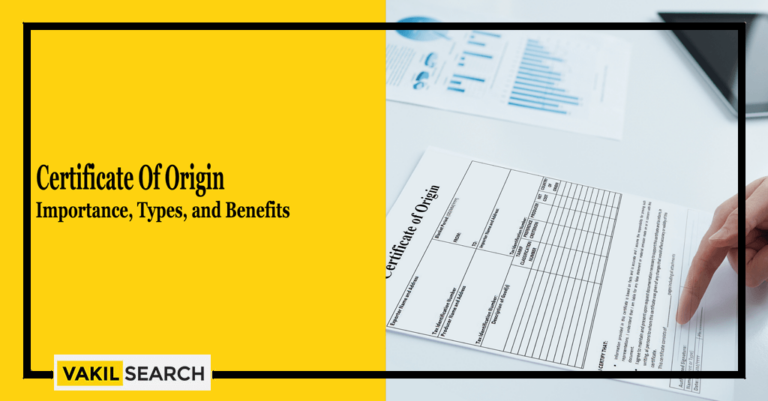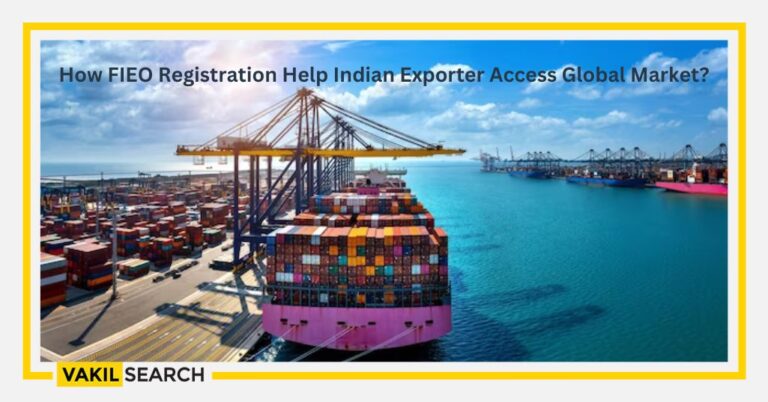A Certificate of Origin confirms the manufacturing country of goods, necessary for customs clearance and trade compliance. Get it online or contact authorised agencies for issuance and details.
What is a Certificate of Origin?
A Certificate Of Origin (COO) is a document that identifies the country where manufacturers produced goods or commodities. It contains details about the product, destination, and export countries. It is a vital document for international trade, required as per trade agreements and treaties between nations.
What Does It Mean?
A Certificate of Origin can establish a product or commodity’s country of origin. The product’s COO includes additional information such as the final destination and the countries from where they were shipped. When doing business across international borders or exporting goods, you must have this document to comply with international accords and treaties governing trade.
Who Issues a Certificate of Origin?
The Indian Chamber of Commerce and the Trade Promotion Council of India issue the COO. This certificate is crucial for Indian exporters to verify the Indian origin of the exported commodities. It confirms that India wholly obtains, manufactures, or produces the exported goods. Entities globally widely issue Certificates of Origin to facilitate international trade and commerce.
To acquire a CO, the exporter must sign it along with a permanent indemnity bond on a non-judicial stamp paper valued at ₹10, duly notarised. The Certificate of Origin Department provides the format for the indemnity bond. Furthermore, the Chamber of Commerce or an authorised authority must sign and stamp the certificate. This document serves as crucial evidence in establishing the origin of goods.
Importance of Certificate of Origin (COO)
Customs clearance primarily requires a COO. If the exported or imported goods lack a CO, the customs officer overseeing the goods’ inspection will prohibit their release from the warehouse. Customs officers use the COO to determine the applicable duties and verify the legality of the exported or imported goods.
Significance of the COO
The CO holds significant importance in the transportation of goods across borders. It serves as proof of the country where the product was manufactured, ensuring transparency and preventing any fraudulent attempts to manipulate the country of origin.
When the origin of goods is clearly evident, it simplifies the process of imposing duties or granting exemptions on the product. Moreover, the ability to import goods is of utmost importance, as certain countries have restrictions on specific goods, and non-compliance with these regulations can result in severe penalties.
For this reason, numerous stakeholders engage in international trade and provide information about the country of origin for their products. Both officials and consumers involved in transportation are keen on knowing the country of origin for each individual item.
In many instances, buyers typically seek certification from the chamber of commerce alone. However, there are situations where they may qualify for utilising the Generalised System of Preferences (GSP) implemented in certain countries. It is essential to have an accurate duplicate of the commercial transaction invoice accompanying the certification for the certification to be granted.
When is a COO Needed?
Issuing a CO becomes compulsory when products are being exported from a specific country. Adhering to this requirement is essential for anyone engaging in business activities in foreign markets. The availability of certification is not limited to nearby cities or even within the country itself.
Like any other document, a Certificate of Origin is subject to specific regulations. The challenge lies in the fact that each country has its own set of rules, and it is the responsibility of the importer in the destination country to be familiar with them.
Certain countries accept a Declaration of Origin printed on a company’s letterhead, which suffices for those locations. However, stricter rules apply in other nations where the COO requires notarisation. In such cases, a local Chamber of Commerce must provide a signed endorsement, authorised by the relevant Department of Commerce. This process is applicable in various countries within the Middle East.
Types of Certificates Of Origin
While there is no universally standardised form for a Certificate of Origin (CO) in global trade, it typically includes essential information such as product details, tariff code, exporter and importer information, and the country of origin. The exporter, familiar with the importing country’s border control requirements, gathers this information, obtains notarisation of the CO from a chamber of commerce, and includes the form with the shipment. Specific requirements may vary based on the type of goods being exported and their destination.
The two different types of COs are,
-
Non-Preferential COs
An ordinary Certificate of Origin (CO), also known as a non-preferential CO, indicates that the exported goods do not qualify for reduced tariffs or duty-free treatment under trade agreements between countries.
If there is no treaty or trade agreement between the exporting and importing countries, the need for an ordinary CO arises. Similarly, if a particular product being shipped does not qualify for tariff relief, it must be declared using an ordinary CO.
-
Preferential COs
Preferential Certificates of Origin (COs) signify the existence of a free trade agreement or reduced tariffs between countries. For instance, exports between the United States, Mexico, and Canada are exempt under the USMCA free trade agreement and require a preferential CO. In such cases, a commercial invoice or bill of lading may be used instead.
The Generalised System of Preferences (GSP) was introduced in the U.S. by Congress in 1974 with the aim of fostering economic growth in disadvantaged nations. It provides duty-free access to numerous products imported from over a hundred countries that have been granted preferential status.
Presently, countries such as Bolivia, Cambodia, Haiti, Namibia, and Pakistan, along with various other developing nations, are included on the list. Additionally, the European Union (EU) and countries worldwide have implemented their own variations of the Generalised System of Preferences (GSP), primarily aimed at promoting economic development through trade with allied nations.
Benefits From Tariff Preferences In India
-
The generalized preference system is abbreviated as GSP.
This method benefits industrialized and rich nations since it gives developing countries priority status in the trade tariffs imposed by those countries. In this unilateral and non-contractual approach, tariff concessions are not shown in exchange for one another.
-
Under the context of the Global Trade Preference System, preferences
Using this technique makes it possible to bring about reductions in tariffs for trade between developing nations that are parties to an agreement. The Export Inspection Council is the body that issues the Certificate of Origin for GSTP (EIC).
-
The Trans-Pacific Partnership, sometimes known as the TPP
Thanks to APTA, India, China, South Korea, Sri Lanka, and Bangladesh are all eligible for tariff reductions. The efforts of APTA to reduce tariff and non-tariff obstacles to trade will be to the region’s advantage, overseen by the Economic and Social Commission for Asia and the Pacific (ESCAP).
-
Agreement Concerning International Trade (ISLFTA)
A free trade agreement (FTA) between India and Sri Lanka has been signed. As a direct consequence of this agreement, EIC is the only entity with the authority to issue Certificates of Origin.
-
India-Thailand FTA:
By the terms of this agreement between India and Thailand, the Early Harvest Scheme will be awarded preferential tariff treatment for the goods it covers. Notice number 101/2004-Customs was issued by the Ministry of Finance’s Department of Revenue, Customs on August 31, 2004.
They established the Rules of Origin requirements, which grant duty benefits for commodities imported under the Early Harvest Scheme of the India-Thailand Free Trade Agreement that meet these requirements. In line with the terms of this protocol, the only organization permitted to issue Certificates of Origin is the Export Inspection Council (CO).
-
Comprehensive Economic Partnership Agreement Between India and Malaysia
As a result of an agreement between India and Malaysia, the EIC has the only authority to issue Certificates of Origin for goods.
-
Concurrence (CEPA)
The Comprehensive Economic Partnership Agreement (CEPA) was signed between India and the Republic of Korea to develop economic and commercial ties between the two nations. As a direct consequence of this agreement, EIC is the only entity with the legal authority to issue COO. Japan and India have agreed to form a partnership to promote comprehensive economic cooperation.
-
India and the Association of Southeast Asian Nations Have Reached a Free Trade Agreement:
An agreement was made between India and Japan to ensure the security of any financial transactions between the two nations. Under these parameters, the EIC is the only entity with the authority to issue Certificates of Origin.
How to Provide Evidence Of A Product’s Country Of Origin?
Customs agents need a Certificate of Origin show to establish where a product comes from. Customs officials will not permit the export or import of goods without a Certificate of Authenticity (CoA). The Certificate assists the Customs officer in determining whether the items are prohibited.
If they are, they will establish the appropriate tariffs.
Paperwork Required to Obtain Certificate of Origin
- Composed at the very last moment before the CoA is sent.
- Information about the product’s export, including amount and provenance.
- A second copy of the packing list corresponds to the corresponding invoice.
- Each of the Certificates of Origin has been copied eight times.
- The cost associated with each certificate.
How to Obtain a COO?
Depending on the nation you are exporting to and whether or not you are eligible to take advantage of cheaper tariff rates, obtaining a CoA could require you to get in touch with several different government authorities.
How to Get a Certificate of Origin?
- Visit the official website of the government: https://coo.dgft.gov.in/.
- Click on ‘Online Services’ and select ‘Online Exporter Login.’
- Use your IEC number as the username and password.
- Click on ‘Online Application’ to apply for a COO.
- Upon successful login, a new window will appear with the option to launch a new application.
- Choose the desired type of COO from the list of preferential and non-preferential certificates.
- Fill in the required details, including the type of COO Issuing Agencies, Free Trade Agreement type, State, State Regional offices, issuing office, etc.
- The issuing of a preferential COO occurs upon export shipment, granting tariff preference based on the signed trade agreement.
- The preferential COO is crucial for exporting to countries under trade agreements.
- Depending on the agreement, refer to it as AIFTA COO (Asian) or APTA COO (Asia Pacific).
- Provide exporter and importer details, including names, addresses, and countries.
- Include a comprehensive product description and the correct HS Code.
- Upload necessary documents such as invoice copy, shipping bill, bill of lading/airway, packing list, etc. Invoice copy is mandatory.
- Agree to the Terms and Conditions on the Declaration page and complete the application with a digital signature, including your name, place, and designation.
- Pay the required government fees and submit the application to the designated agencies.
Procedure for Issuing Certificates of Origin
Free Trade Agreement Certificates of Origin
Exporters participating in free trade agreements with the U.S. and other countries may need to submit a designated form as evidence of origin. This action enables their products to qualify for preferential duty rates. Various sources, including the U.S., provide examples of such forms. Customs and Border Protection website, export.gov, or the customs or chamber of commerce websites of the destination country.
Furthermore, on the shipping solutions website, you have the option to access sample certificates of origin for various countries, including Australia, CAFTA-DR, Chile, Colombia, Korea, and the USMCA (which replaced NAFTA).
What’s Included on a Certificate of Origin?
Certificates of origin will typically contain the following information;
- Producer’s name and contact information, along with the country of origin
- Exporting agent’s name and contact information
- Receiver’s or importing agent’s name and contact information
- Description of the product(s) with corresponding HS codes
- Quantity, size, and weight of the item(s)
- Waybill or bill of lading number
- Mode of transportation and route details
- Dated commercial invoice for payment
- Any additional notes or remarks
Certificate of Origin for Export From India
The provenance certificate provides evidence of the origin of the goods exported from India. Customs authorities in the importing country require it to facilitate smooth customs clearance and ensure adherence to trade laws. Also, the certificate includes essential details such as the exporter’s name, product description, and country of origin.
COO for Import
The Certificate of Import Provenance validates the origin of the products entering a country. It provides information about the country where manufacturers produced or manufactured the goods. Customs officials frequently require this certificate to determine relevant tariffs, trade agreements, and ensure compliance with import regulations. It helps establish the authenticity and origin of the imported items.
Certificate of Origin for a Vehicle
The COO for a vehicle serves as an official document confirming the country of production or origin. Furthermore, it discloses the precise location where manufacturers manufactured or assembled the vehicle. This document is often a requirement for vehicle registration and import/export procedures to authenticate the vehicle’s origin and ensure compliance with relevant laws.
Certificate of Origin for a Trailer
The COO for a trailer is an official document that verifies the country of origin or place of manufacturing. It furnishes precise details regarding the construction or manufacturing location of the trailer. Furthermore, regulatory compliance for purposes such as registration, importation, and exportation often necessitates this certificate to establish the trailer’s origin.
Conclusion
Certificate Of Origin – Chambers of commerce may be helpful resources for businesses that export goods. Keep abreast of the activities at your local chamber of trade so that you won’t lose out on any opportunities to participate in events or initiatives relevant to exporting. Vakilsearch can help you with more information on these topics.
FAQs
Certificate of Origin is issued by whom?
The COO is issued by the Trade Promotion Council of India and the Indian Chamber of Commerce.
Is it possible to get a Certificate of Origin online?
Yes, you can obtain an online COO by visiting the following link- https://coo.dgft.gov.in/users/login?type=ZXhwb3J0ZXI%3D.
What is a Certificate of Origin for export?
The COO is an essential document in international trade. It verifies that the products included in a particular export shipment are entirely obtained, produced, processed, or manufactured in a single country. It declares the nationality of the goods and serves as a statement by the exporter to fulfil trade or customs requirements.
Who gets the COO?
Typically, it is the exporter or the goods' manufacturer who obtains the Certificate of Origin. They hold the responsibility of securing the certificate to validate the origin of the exported goods.
How do I get a COO online?
Exporters are responsible for issuing and completing Certificates of Origin (COs) for their goods. The CO may undergo approval by a chamber of commerce before the shipment takes place.
Where can I get a Certificate of Origin in India?
In India, the Certificate of Origin can be acquired from authorised agencies or organisations duly acknowledged by the government. These entities encompass chambers of commerce, export promotion councils, and designated government offices such as the Directorate General of Foreign Trade (DGFT). To learn about the process and prerequisites for obtaining the Certificate of Origin, you can reach out to these entities for further information.
What is the cost of a Certificate of Origin?
The price of a Certificate of Origin may differ depending on various factors, such as the issuing agency, type of goods, and any additional services required. For precise information regarding the cost, it is advisable to get in touch with the issuing agency.
Can I get a Certificate of Origin from another state?
It is possible to acquire a Certificate of Origin from a different state by adhering to the regulations and procedures set by the authorised issuing agency in that particular state.
What is certificate proof for origin?
Certificate of Origin is a document that certifies the country in which the goods originated. It provides proof of the product's origin and is essential for international trade, often required by customs authorities.
What is a certificate of origin for a merchant exporter?
A Certificate of Origin for a merchant exporter is a document that confirms the origin of goods being exported. It ensures transparency in international trade and helps in availing preferential treatment under trade agreements.
Does DGFT issue certificates of origin?
Yes, the Directorate General of Foreign Trade (DGFT) is responsible for issuing Certificates of Origin. These certificates may be required for various trade-related purposes.
How much does a Certificate of Origin cost?
The cost of a Certificate of Origin varies and is often determined by the issuing authority or chamber of commerce. It is advisable to check with the relevant organisation for the current fee structure.
What is the validity of Certificate of Origin for export?
The validity of a Certificate of Origin depends on the regulations of the exporting and importing countries. In many cases, it is valid for a specific period, such as six months or one year, from the date of issuance. After expiration, a new certificate may be required.
What is the difference between COO and COC?
How Can I validate a Certificate of Origin?
For the 'CO Number or CO Reference Number,' input the numerical value displayed in red at the upper right corner of the form. Be sure to incorporate both the prefix and hyphens, such as AW-00-00000. In the 'Date' field, input the date from the Certificate located at the lower left of the form, just above the signature.
What is Certificate of Origin Form B?
A Certificate of Origin under the Asia-Pacific Trade Agreement (Form B) serves as documentation necessary for authorities in the importing country to verify the origin of the goods. This certificate remains valid for a duration of one year starting from the issuance date.
What is a COO for a shipment in India?
When engaging in export activities from India, sellers must acquire several documents to facilitate smooth cross-border trade of goods. Among these essential documents is the Certificate of Origin (COO), which validates that the exported products have undergone manufacturing and processing within the specific country.
What is Certificate of Origin Form E?
The initial Certificate of Origin (Form E) must be presented to the Customs Authority during the import declaration process for the relevant products, asserting eligibility for preferential treatment as per the domestic laws, regulations, and administrative rules of the importing Party.
Is it Possible to import without Certificate of Origin?
Products imported under a trade agreement must be accompanied by a 'Certificate of Origin' (COO) issued by the authorised body in the exporting nation.










